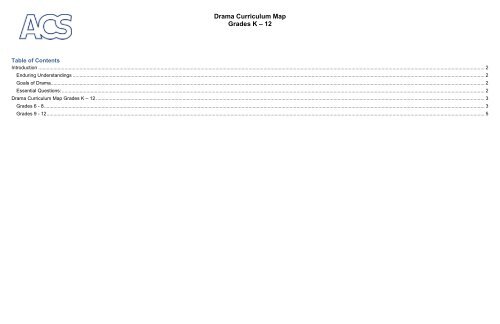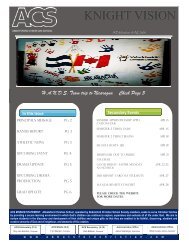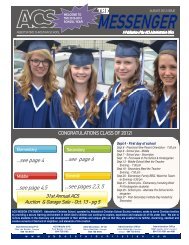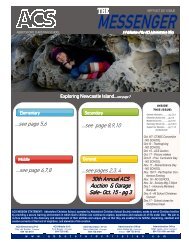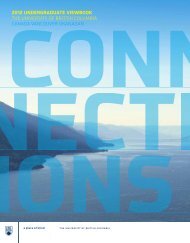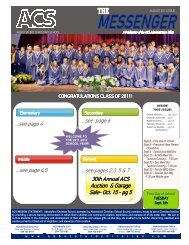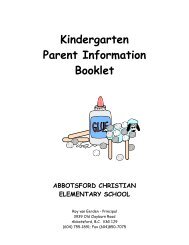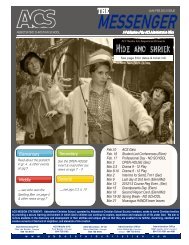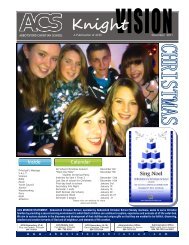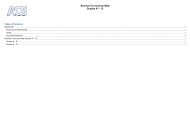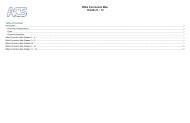Drama Curriculum Map Grades K â 12 - Abbotsford Christian School
Drama Curriculum Map Grades K â 12 - Abbotsford Christian School
Drama Curriculum Map Grades K â 12 - Abbotsford Christian School
- No tags were found...
Create successful ePaper yourself
Turn your PDF publications into a flip-book with our unique Google optimized e-Paper software.
characterization?7. How is improvisation both funny and serious atthe same time?8. How does comedy improve relate to real life? Mirrors Pass the Impulse Pass the Sound Hello Jello Dance Game Hug Game Lions, Tigers, and Bears, oh my.2. Short Scene creation based on the first week of school.3. Tableaux series based on one event and the effects of it.4. Serious improvised scenes based on given situations and conflicts (focus onthe four elements of theatre – focus, tension, contrast, and balance).5. Character creation through movement and vocal exercises. Scene creationbased on these characters (focus on the five parts of a scene – character,setting, problem, raising the stakes, solution).6. Improv. Comedy unit which focuses on rules and elements of Improv. and thefive parts of the scenes, includes the following improvised games andactivities:• Panic Squad “Your Title Here.”• Emotional Improv.• Freeze• Party Quirks• Moving People• Slideshow• Park Bench• Alphabet game• Six person Scene• Pick Up Lines• Unit also focuses on Schurtleef’s Guideposts for acting including:Moment Before, Importance, Place, and What are you Fighting For?”• Unit culminates with a completion displaying skills through activeparticipation in all of the games.7. Scripted Scene Study which includes:• Character development• Set design• Line memorization• Blocking• Teacher side-coaching• Discovery and implementation of motivations and intentions.• Discovery of theme.• The opportunity to learn from the rehearsal process of others – selfand peer assessment.Rehearsals, journaling, and performance in front of audience.It is expected that students will use body and voice expressively in the discipline ofdrama.4. DRAMA SKILLS (Role)It is expected that students will maintain concentration and focus while in role andexperience the duality of being both participant and observer within a dramatic context.5. DRAMA SKILLS (<strong>Drama</strong> as Metaphor)It is expected that students will develop the facility to move between the concrete and theabstract within a dramatic context.6. DRAMA SKILLS (Elements and Structures)It is expected that students will understand and apply the elements of drama and theatre.7. DRAMA SKILLS (Technique)It is expected that students will apply technical skills and knowledge to enhance dramaticcommunication.8. CONTEXT (Social and Cultural Context)It is expected that students will experience, understand, and develop sensitivity to thediversity of cultures through drama. Students will also interpret how drama celebrates,comments on, and questions the values, issues, and events of societies past andpresent.9. CONTEXT (Making Connections)It is expected that students will acquire knowledge, skills, and attitudes through the studyof drama that enhance their understanding of other art forms and contribute to theirpersonal, educational, and career development.
<strong>Grades</strong> 9 - <strong>12</strong>Planning for Assessment (Teaching Strategies), Assessment Indicators (Assessment Activities) and resources are listed in course overviewsGrade Essential Questions/Unit Questions Content Learning Outcomes: By the end of grade level, the students will: Performances9/10MimeTaughtalternateyearswith9/10StageCombatWhat is good drama that honours God?Unit 1 Introduction to <strong>Drama</strong> What is story? What is blocking? What is character? How do you develop astrong character through costume, blocking,and self- expression? What is a character’s intention in a scene? What is plot? What is a strong plot that drivesthe action forward? How can you speak through secular and<strong>Christian</strong> music?Unit 2 Mask and Mime How do you create positive and negativespace using mime? How do you create a character using mime? What can you apply to regular characterdevelopment using the skill you have learnedin mime?Unit 3 Film Production What is the difference between drama andfilm? How does film complement drama and viceversa? How do you film a scene? How do you edit film?Unit 4 One Act Production (student directed OneAct Play) How does character effect dramatic tension? How do character, blocking, voice, costume,and set culminate in the use of a script?Unit 1 Introduction to <strong>Drama</strong> Fortunately/unfortunately Buzz/flop/splash Scene: Soap Opera Character Impersonation Scene – Use 2 opposing intentions to create conflict in a scene Scene – The Mad _______ Scene: Pass Around Scene Scene: Oral Sound FX Scene: Scene with Sd Fx cd given location for plotUnit 2 Mask and Mime Paper maché emotion mask Character exerciseso Object improvisationo Garbage pickero Erase a faceo Masqueradeo Simple mimeo $20 on a bencho Analysis of movemento The puppeto Room and chair scenario Exercises with maskso Erase a faceo Masqueradeo Four basis movementso Masks in choruso Exploration of charactero The change scenarioo The mirror scenarioo Encounter labo Clothes pile scenarioo Assembly line factoryo Story improvisation Mime done to a piece of literature (narrated) or a piece music with a storyUnit 3 Film Production – working collaboratively with Comm. 11/<strong>12</strong> Develop a 30 second commercial Film and edit a 1 min. “how to” video Find the “hero’s journey” in a variety of films Develop a script following the form of a “hero’s journey” Use this script to create a short film Film and edit a mime to a song (music video)Unit 4 One Act Production (student directed One Act Play) Student directed one act play(more detail on each learning outcome can be found on the Ministry of Education websiteunder <strong>Curriculum</strong>)1. EXPLORATION AND IMAGINATION (Expression and Trust)It is expected that students will trust themselves and others in order to express and reflecton thoughts, feelings, and beliefs; to take risks within a dramatic context; and to expressthemselves through active engagement in drama.2. EXPLORATION AND IMAGINATION (Critical Analysis)It is expected that students will evaluate and analyse the contributions of self and otherswithin the dramatic context.3. DRAMA SKILLS (Body and Voice)It is expected that students will use body and voice expressively in the discipline ofdrama.4. DRAMA SKILLS (Role)It is expected that students will maintain concentration and focus while in role andexperience the duality of being both participant and observer within a dramatic context.5. DRAMA SKILLS (<strong>Drama</strong> as Metaphor)It is expected that students will develop the facility to move between the concrete and theabstract within a dramatic context.6. DRAMA SKILLS (Elements and Structures)It is expected that students will understand and apply the elements of drama and theatre.7. DRAMA SKILLS (Technique)It is expected that students will apply technical skills and knowledge to enhance dramaticcommunication.8. CONTEXT (Social and Cultural Context)It is expected that students will experience, understand, and develop sensitivity to thediversity of cultures through drama. Students will also interpret how drama celebrates,comments on, and questions the values, issues, and events of societies past andpresent.9. CONTEXT (Making Connections)It is expected that students will acquire knowledge, skills, and attitudes through the studyof drama that enhance their understanding of other art forms and contribute to theirpersonal, educational, and career development.Short scenes for in class performancesVideo may be used for chapel or air bandOne act plays performed for several otherclasses and at Open House
9/10StageCombatTaughtalternateyearswith9/10MimeWhat is good drama that honours God?Unit 1 Introduction to <strong>Drama</strong> What is story? What is blocking? What is character? How do you develop astrong character through costume, blocking,and self- expression? What is a character’s intention in a scene? What is plot? What is a strong plot that drivesthe action forward? How can you speak through secular and<strong>Christian</strong> music?Unit 2 Stage Combat What real life experiences can relate to stagecombat? How is stage combat used effectively in filmand drama? How does stage combat effect plot; how doesplot effect stage combat?Unit 3 Script and Film Production What is the difference between drama andfilm? How does film complement drama and viceversa? How do you film a scene? How do you edit film? How does blocking enhance drama?Unit 4 One Act Production (student directed OneAct Play) How does character effect dramatic tension? How do character, blocking, voice, costume,and set culminate in the use of a script?Unit 1 Introduction to <strong>Drama</strong> Fortunately/unfortunately Picking a fight Fatal story Buzz/flop/splash Scene: Story by a Name Story telling by claps Create a statue Walk across the room Scene: a scene with stereotypes Scene: Shakespeare Lingo Scene: Bible Time Balancing a partner Blind walk Simple Scene – pull out an actor Scene: 30 second commercial Editing with Premiere Scene of a form Scene: 10 sd fx using voice Scene: Scene with 6 Sd Fx cd given location for plotUnit 2 Stage Combat Basic moves and safety Practice moves and present scenes Scene: create a scene that leads to a fightUnit 3 Script and Film Production 30 second video commercial 3 minute video of superheros Script writing and plot Outline a plot Write script A few best scripts are produced into a film or play by student directorUnit 4 One Act Production (student directed One Act Play) Student directed one act play(more detail on each learning outcome can be found on the Ministry of Education websiteunder <strong>Curriculum</strong>)1. EXPLORATION AND IMAGINATION (Expression and Trust)It is expected that students will trust themselves and others in order to express and reflecton thoughts, feelings, and beliefs; to take risks within a dramatic context; and to expressthemselves through active engagement in drama.2. EXPLORATION AND IMAGINATION (Critical Analysis)It is expected that students will evaluate and analyse the contributions of self and otherswithin the dramatic context.3. DRAMA SKILLS (Body and Voice)It is expected that students will use body and voice expressively in the discipline ofdrama.4. DRAMA SKILLS (Role)It is expected that students will maintain concentration and focus while in role andexperience the duality of being both participant and observer within a dramatic context.5. DRAMA SKILLS (<strong>Drama</strong> as Metaphor)It is expected that students will develop the facility to move between the concrete and theabstract within a dramatic context.6. DRAMA SKILLS (Elements and Structures)It is expected that students will understand and apply the elements of drama and theatre.7. DRAMA SKILLS (Technique)It is expected that students will apply technical skills and knowledge to enhance dramaticcommunication.8. CONTEXT (Social and Cultural Context)It is expected that students will experience, understand, and develop sensitivity to thediversity of cultures through drama. Students will also interpret how drama celebrates,comments on, and questions the values, issues, and events of societies past andpresent.9. CONTEXT (Making Connections)It is expected that students will acquire knowledge, skills, and attitudes through the studyof drama that enhance their understanding of other art forms and contribute to theirpersonal, educational, and career development.Short scenes for in class performancesBest scriptsOne act plays performed for several otherclasses and at Open HouseActing11Unit 1 Introduction to <strong>Drama</strong> What is good drama that honours God? What gifts can I offer the ensemble? What is a <strong>Christian</strong>’s role in Theatre? How is theme expressed in video, poster andadvertising? How do we tell a story worth telling?Unit 2 Student Directed One Act Plays What is the role of the director? How is character and plot developed in ascript? What are appropriate decisions for a director?Unit 1 Introduction to <strong>Drama</strong> Fortunately/unfortunately Alibi Scene of a style Scene: create a scene by passing apiece of paper around to different groupsand having each group give one of: setting, protagonist, antagonist, andproblem. Group must use 3 of the 4. Participate in improvisationUnit 2 Student Directed One Act Plays Analyse a one-act play Prepare to be a director of a portion of a script: cast roles, prepare to direct,run an exercise (evaluate director/actors)1. EXPLORATION AND ANALYSISa. describe their aesthetic response to a theatre performance in terms of:- drama form- style- elements of drama- meaning- use of performance elements- use of production elementsb. describe characteristics of successful performancec. demonstrate engagement in performanced. demonstrate a willingness to take performance risks in a variety of situationse. apply the creative process of exploration, selection, combination, refinement, andreflection to performancef. critique their own work and that of othersg. use appropriate terminology to describe theatre performanceCommunity Performance
How do technical aspects support drama?Unit 3 Video Production What messages is our culture telling us? How do you interpret music as theatre? How is story told in music videos?Produce a production for a dinner theatre evening (Acting <strong>12</strong> directing unit)o Students participate as actorso Project related to costume, promo, video, props, make-up, tickets,sound or lightingChoose a full length play and choose a scene for 2 actors – test on scene incontext of full length playUnit 3 Video Production Create a music video of a song of student choice2. PERFORMANCE SKILLS (Body and Voice)a. demonstrate voice and movement elements appropriate to performanceb. demonstrate understanding of the body and voice as performing instrumentsc. apply safety and health considerations to body and voiced. identify appropriate theatre terminology to describe movement and voice3. PERFORMANCE SKILLS (Characterization)a. identify a character’s objectives and motivationsb. identify range of internal and external strategies to developing characterc. demonstrate appropriate strategies to develop a character4. PERFORMANCE SKILLS (Elements and Structures)a. demonstrate understanding of standard script conventions and structuresb. identify a range of drama formsc. demonstrate understanding of the use of elements of drama in performanced. demonstrate understanding of how a central image contributes to a unifiedperformancee. demonstrate understanding of how production elements affect performancef. use appropriate stage terminology5. CONTEXTa. identify cultural and historical contexts that influence and are influenced by theatreb. analyse how performance elements are used in theatre works to achieve specificpurposes and reach specific audiencesc. analyse purposes and styles of drama of traditional and contemporary Aboriginalpeoples in BCd. demonstrate understanding of theatre styles in selected cultures and historicalperiodse. identify the relationship between theatre performance and other Artforms6. COMPANYa. demonstrate understanding of the roles and responsibilities of theatre companypersonnelb. demonstrate commitment to the rehearsal and performance processc. identify processes and protocol involved in theatre pre-production, production, andpost-productiond. demonstrate appropriate performance etiquettee. demonstrate a willingness to delegate and accept responsibility in a groupf. demonstrate health and safety practices in theatre performanceg. set personal goals for theatre performanceh. identify requirements for careers in theatre performance and arts related fieldsActing<strong>12</strong>Unit 1 Introduction to <strong>Drama</strong> What is good drama that honours God? What gifts can I offer the ensemble? What is a <strong>Christian</strong>’s role in Theatre? How is theme expressed in video, poster andadvertising? How do we tell a story worth telling?Unit 2 Student Directed One Act Plays What is the role of the director? How is character and plot developed in ascript? What are appropriate decisions for a director? How do technical aspects support drama?Unit 3 Video Production What messages is our culture telling us? How do you interpret music as theatre? How is story told in music videos?Unit 1 Introduction to <strong>Drama</strong> Fortunately/unfortunately Alibi Scene of a style Script Writingo Analyse script writing, character development and ploto Write a 10 – <strong>12</strong> page script to be performed with TPA 11 Participate in improvisationUnit 2 Student Directed One Act Plays Order scripts for production Analyse script for production Cast roles and prepare for a performance run of 2 – 3 evenings Produce a production for a dinner theatre evening (Acting <strong>12</strong> directing unit)o Students participate as actorso Project related to costume, promo, video, props, make-up, tickets,sound or lighting Read a full length play and choose a scene for 2 actors – test on scene in1. EXPLORATION AND ANALYSISa. justify their aesthetic response to a theatre performance in terms of:- drama form- style- elements of drama- meaning- use of performance elements- use of production elementsb. apply skills and techniques to communicate thoughts, feelings, and beliefs in a theatreperformancec. maintain engagement in performanced. demonstrate the ability to move in and out of rolee. take performance risks in a variety of situationsf. critique their own and others’ performancesg. use appropriate terminology to describe theatre performance2. PERFORMANCE SKILLS (Body and Voice)a. demonstrate proficient use of body and voice as performing instrumentsb. use selected voice elements and elements of movement to achieve a specificpurposec. apply safety and health considerations to body and voiced. use appropriate theatre terminology to describe movement and voice3. PERFORMANCE SKILLS (Characterization)Community Performance
POL (presentation of learning) of decisions for design and final production construction and application of:- sets- props- lighting- sound- costumes- hair and makeup- masks- special effectsd. practise safety procedures in using theatre production equipment, processes, andmaterialse. use appropriate theatre terminology in relation to materials and equipment4. PRODUCTION SKILLS (Management)a. demonstrate the ability to plan for pre-production, production, and post-productionphasesb. identify theatre management skills and procedures in relation to:- organization- communication- theatre personnel- facilities, equipment, and materials- leadership and the chain of commandc. identify the roles and responsibilities of managers in theatreproduction:- production manager- stage manager- house manager- technical directord. demonstrate the ability to undertake the roles and responsibilities of a manager intheatre productione. identify the roles and responsibilities of production crew heads in rehearsal andproductionf. identify the components of a production scheduleg. assess physical, time, and budgetary considerations for production5. CONTEXTa. identify cultural and historical factors that influence and are influenced by theatreb. apply knowledge of selected cultures and historical periods to theatre productionc. identify the economic and social impacts of theatre production on local and globalcommunitiesd. demonstrate understanding of the effects of other artforms on theatre production6. COMPANYa. identify the roles and responsibilities of theatre company personnelb. describe the interrelationships of various positions in a production teamc. demonstrate commitment to the production processd. describe procedures and etiquette for backstage and front-of-house communicationduring performancee. demonstrate understanding of health and safety procedures and standards for theatreproductionf. set personal goals for theatre productiong. identify requirements for careers in theatre production and artsrelated fieldsTheatreProduction<strong>12</strong>Introduction to Theatre Production How do you create an effective theatre space? What is good drama that honours God? What is balance in design? How does the set support the acting andscript? How do the individual pieces of the set fittogether to serve the whole?Theatre Production Read script chosen by TPA 11/<strong>12</strong> student director Meet with TPA 11/<strong>12</strong> director Present ideas to student director and problem solve design Sketch design with swabs of colour and finish ideas Draft a design for the stage Build a model Present model to Acting class for final approvalTheatre Production <strong>12</strong>1. EXPLORATION AND ANALYSISa. justify aesthetic response to a theatre presentation in terms of:- drama form- style- elements of drama- meaning- use of production elements- use of performance elementsb. critique their own and others’ theatre production projectsCommunity Performance


